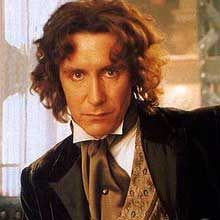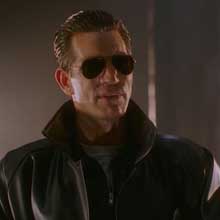Having eventually enjoyed the modern-day RTD-helmed reboot of Doctor Who and what is arguably its second modern-day reboot in the form of the fairytale-style Moffat and Smith series, I thought it was worth giving the failed 1996 reboot a second look to see why it never made it.
In a nutshell: it’s because it does almost everything wrong.
The largest mistake it makes is in trying to use this one episode to explain to a new, American audience almost everything there is to know about the Doctor. Instead of leaving the character as a cipher, a mystery to be unravelled through the eyes of his companions — the audience proxy — this pilot lays it all out up front.
 About a quarter of the episode is given over to the death of the Sylvester McCoy’s Doctor and the Master and their subsequent regenerations into Paul McGann and Eric Roberts respectively. References are made to The Master, Daleks and Skaro, Gallifrey, the number of lives a Time Lord has, the enmity between Master and Doctor…it’s all pretty boring and there’s enough material there to fill up several episodes so it feels longer than it actually is. McGann’s Doctor is also given a temporary bout of amnesia to stretch out the exposition even further.
About a quarter of the episode is given over to the death of the Sylvester McCoy’s Doctor and the Master and their subsequent regenerations into Paul McGann and Eric Roberts respectively. References are made to The Master, Daleks and Skaro, Gallifrey, the number of lives a Time Lord has, the enmity between Master and Doctor…it’s all pretty boring and there’s enough material there to fill up several episodes so it feels longer than it actually is. McGann’s Doctor is also given a temporary bout of amnesia to stretch out the exposition even further.
What was most likely an attempt to please both newcomers and existing fans ends up pleasing neither. Newcomers don’t need to know any of this right away: the RTD reboot drip-fed the audience details, characters and species over several seasons. Fans, meanwhile, would likely be sitting there fuming over details like the Doctor suddenly being half-human, his penchant for kissing his companion or the Master somehow being on Skaro tried by Daleks when he was last seen on an exploding planet at the end of Survival. Case in point.
It’s also far more violent than British audiences would have been used to for a Sunday tea-time family show. We start off in the middle of a gun fight between Asian-American gangs and several people are dead before the TARDIS has landed. When the TARDIS does appear, McCoy’s Doctor gets unceremoniously gunned down as he steps out. He’s taken to hospital where he is forcibly anaesthetised, protesting as he goes, and is killed during exploratory surgery by a micro-camera forcibly inserted into one of his two hearts. This is gruesome stuff!
 Factor in car chases, gun fights, the Master being played by a lizard-eyed, flesh-rotting American — complete with Terminator-style leathers and sunglasses — the whole thing just feels too American to really be Doctor Who. The TARDIS and the character of the Doctor seemed relatively intact but this is more of a spin-off, re-interpreted for an American audience, than a triumphant return.
Factor in car chases, gun fights, the Master being played by a lizard-eyed, flesh-rotting American — complete with Terminator-style leathers and sunglasses — the whole thing just feels too American to really be Doctor Who. The TARDIS and the character of the Doctor seemed relatively intact but this is more of a spin-off, re-interpreted for an American audience, than a triumphant return.
These shoes! They fit perfectly!
 It isn’t all bad. There’s the TARDIS itself: it’s magnificent, all brass and steampunk and vintage chic. OK, every other incarnation’s TARDIS is bigger on the inside, and the Ninth, Tenth and Eleventh Doctors’ space is pretty roomy but what we see here actually does look like someone 900 years old might be living in it. There are rooms. Shelves full of stuff. There’s masonry, dead leaves and dust. At one point there are actually bats. It’s how a TARDIS ought to be, looking like Jay Walker’s library instead of a cheap set.
It isn’t all bad. There’s the TARDIS itself: it’s magnificent, all brass and steampunk and vintage chic. OK, every other incarnation’s TARDIS is bigger on the inside, and the Ninth, Tenth and Eleventh Doctors’ space is pretty roomy but what we see here actually does look like someone 900 years old might be living in it. There are rooms. Shelves full of stuff. There’s masonry, dead leaves and dust. At one point there are actually bats. It’s how a TARDIS ought to be, looking like Jay Walker’s library instead of a cheap set.
Then there’s Paul McGann. He does really well! Considering the weakness and incoherence of the script and plot, once he gets into it he soars along mixing cheery asides with scenery-chewing doom-mongering like a pro. He looks and dresses the part and it’s a shame we never got to see more of him outside of the radio plays that I haven’t listened to but which are, apparently, pretty good.
So, yes, with the perspective of someone who’s now seen plenty of the original show and all of the new show, It’s pretty clear why this one died on its arse.